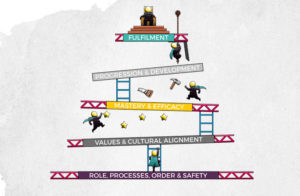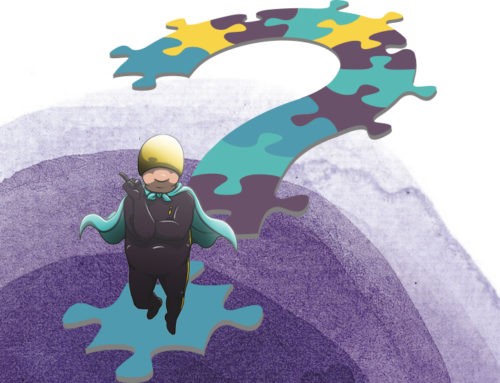
As a business leader you need to bring your people along this journey of Digital Transformation with you. You want them to be engaged, enthused, excited and motivated to get the necessary work done to achieve the goals of the business.
Sound good? Yes? So, how do you go about creating this utopian world?
It’s about recognising and meeting your people’s individual hierarchy of needs. Our work is important to us. It’s an area of our lives where we get to use our skills and expertise, we can demonstrate our talents, we get satisfaction from a job well done and we are rewarded for our efforts. If our work is a place where we can work hard and feel good about what we’re doing whilst contributing to the success of the business, then we have the right environment for creating Digital Transformation.
Let’s examine the pieces of the puzzle that need to come together to make this happen.
Of course it all starts with strategy. Strategy creates the direction, it gives us a plan of implementation, it dictates the outcomes that we’re working towards and the understanding of where we are now. Strategy is the engine that drives the machine and sets the direction of travel. Learn more about creating a digital business strategy here.
When it comes to bringing our people along with us, we need to recognise and meet their individual needs. What happens when we meet our peoples’ individual needs? The ultimate goal for them is fulfilment, to reach their potential. What’s the payoff for the organisation? Engagement and great performance. What happens if you don’t meet these needs? Disengagement, scepticism, poor performance, high staff turnover and ultimately even disciplinary issues leading to HR headaches.
This is not a straightforward employee engaged/disengaged switch. These things happen by degree and there are a lot of steps leading to one outcome or the other. We work to be given the opportunity to do something we’re good at and be rewarded for it. A wonderful organisation to work in is one that makes that possible for us. The potential payoffs for both sides are enormous, and after all no one joins an organisation to do bad work.
The most basic human need is for survival, which means a roof over our heads and the ability to feed ourselves, to keep warm and so on. So at this very basic level, our working lives give us the opportunity to earn a salary to survive in our world. All of this is of course agreed before we even start work, so we’ll take this as read and move on up.
Once we enter an organisation we need to understand our role, how we are to complete our tasks or perform our duties and how we are to get things done. We need to understand the processes and structures, the parameters and boundaries under which we operate and the rules by which we must abide. We also have a need for safety, which is often destroyed in a blame culture.
What do I mean by “safety”? A safe place to fail, and to learn from failure.
Leaders have a responsibility to create an environment where it’s safe to fail. Our people need to feel safe to admit when something has gone wrong, knowing that the consequences will be an examination of the processes that went wrong, efforts will be made to fix the problem and that something will be learned from this experience.
As a business leader your responsibility is to create these processes. Once created your responsibility changes to one of quality control. For brilliant inspiration on how to do this, look no further than Michael E. Gerber’s ‘The E Myth Revisited’. It’s aimed at small businesses and shows exactly how to go about making your business work and how to make it scalable if that is your desire (it’s also a great read).
For larger businesses remember the golden rules. Your processes should support your desired outcomes and empower your people to do their work within the constraints and boundaries needed to ensure your products or services are of the standard you require. Too often processes become the work rather than a means by which our work is completed. We also need to take our customers into account. Our processes need to support their experience too. When we come up against blocks and barriers when trying to achieve our goals, we quickly disengage, our customers go somewhere else and our people can head the same way.
When you have the right processes in place and your people have adopted them, they will naturally improve and perfect them when they see opportunities to do so. When we have the right processes in place we can do our jobs better, we will engage more with our organisations and add value by shaping and improving our processes and our customers’ experiences.
This is a basic need, and once satisfied we can move up to the next level.
Next is our need for a sense of belonging which happens when our personal values match those of our workplace and our work gives us a sense of positive identity. An organisation’s values are expressed in its culture and indeed its very reason for existing. A company’s culture is ‘how we do things around here’. Our culture is expressed in our reward systems, our structures and hierarchies, our communications and even the way we dress and how we talk to one another.
A good cultural fit between new recruits and company culture is a hugely important predictor of job success alongside a general level of intelligence. It’s more important than experience, competencies or demonstrable skills. It’s so deeply engrained in our human experience we don’t even think about it – it’s subconscious. Skills can be learned. Values can’t be realigned. The good news is that values are not massively complicated or difficult. People value honesty, integrity, transparency. Recruit people who genuinely like what you do and why you do it and then make sure that your culture supports your why and rewards and motivates the people who help you get there. See Simon Synek for inspiration on finding your why.
Now we should be starting to get somewhere. We understand our roles and how to achieve our work and we’re in an organisation that gives us a positive sense of belonging.
What’s next? Now we start moving into the region of mastery and efficacy. Most organisations start here when it comes to recruitment but if we get the right people and our processes are right, skills development can come later.
We said earlier that we all work to get the opportunity to do something we’re good at and be rewarded for it. This is where this can start to happen. Mastery and efficacy doesn’t necessarily mean high level super achiever stuff. The same feeling of achievement can come from the most menial tasks – a job well done is a rewarding and satisfying experience whether it’s cleaning the floors or discovering a new planet.
As an organisation or a business leader, it’s your job to ensure your employees have access to the tools, training and practice required to achieve that mastery. It helps to keep things relatively simple. You will no doubt have heard about Jack of all Trades…
After that your leadership role gets a lot easier! You just need to provide the opportunities that will allow your people to keep improving and progressing until we reach our ultimate goal of fulfilling our potential. Of course that won’t always be possible within one organisation and we have to be realistic about the opportunities that exist or can be created. It’s only natural that people will stay in an organisation for a period of time and then move on when they have achieved what they set out to do.
Part of the Digital Transformation process is about meeting individual needs, it’s a vital cog in the wheel, but what are the consequences if we don’t?
Plenty of organisations have good people with good skills and talents, but when we have confusing processes, lack of clarity around roles, a blame culture and a lack of cultural fit what happens? People doing their job and nothing more. Lack of engagement, people refusing to take responsibility, blaming each other for mistakes and ultimately a lack of progression for the business are all symptoms that our needs are not being met.
Now imagine how this plays out when we are undergoing Digital Transformation. If we have people who are disengaged and we ask them to participate in the upheaval and change required by our new strategy, what do you think will happen? More than likely, you’re going to meet resistance. What happens at the top of the ladder when people have achieved a sense of mastery and satisfaction with their progression and we ask them to change? You could still meet resistance. Imagine how hard they have worked to get to where they are. How would you feel about taking a leap into unknown territory? Probably many of you feel some trepidation about leading a Digital Transformation project and are looking for help with the process.
A Digital Transformation Framework gives you the structure and rules you need to create your strategy, your values are obviously already aligned if you’re aiming for the outcomes associated with Digital Transformation and of course you need access to the tools and training that meet your own capability needs to perform your role.
When it comes to bringing your people with you, you have 2 options – the stick and the carrot and to be honest, you’re probably going to need a bit of both. The carrot is the idea of mastery in a new field, reaching new potential, the opportunity to gain new skills that will be highly valued by the organisation and are critical to the success of the newly transformed business. Remember – people choose their jobs to have the opportunity to do something they’re good at and be rewarded for it. This is where a properly thought out and researched strategy is worth its weight in gold. By using a Digital Transformation Framework, you will identify the critical challenges facing the business and use the guiding policies of the framework to create a coherent plan of action. For your people, this takes care of the critical questions of why we need to change, how we’re going to change and what we need to do fulfil our role in bringing about the outcomes. You also need to remain cognisant of our individual hierarchy of needs and make sure you can meet these needs. Think of these as the stepping stones that you need to provide that will allow your people to follow along behind you. Imagine your people asking you to help them fulfil their needs so they can help you to meet yours.
Communicating your strategy to your people is hugely important. In these communications you also need to create a vision of where the organisation is going and give any business as unusual some context. Remember that any change project will have pitfalls and difficulties so it’s essential to avoid a blame culture or the project will fail.
Cultural and business realignment will be required in the Digital Transformation process. You can read more about how to implement this cultural change process and use it to inform your business alignment in our upcoming blogs – sign up to our newsletter to stay up to date.


